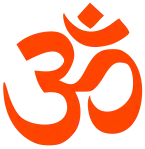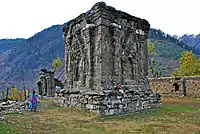Multan Sun Temple
The Sun Temple of Multan, also known as the Aditya Sun Temple,[1] was an ancient Hindu sun temple,[2] that was the base of a sun worshipping sect dedicated to Surya, the Hindu Sun God (also known as Aditya), that is located in the city of Multan, modern day Pakistan.[3]
| Sun Temple of Multan | |
|---|---|
| Religion | |
| Affiliation | Hinduism |
| District | Multan |
| Deity | Surya |
| Location | |
| Location | Multan |
| State | Punjab |
| Country | |
| Geographic coordinates | 30°07′55.9″N 71°26′27.9″E |
| Architecture | |
| Type | Hindu temple |

| Part of a series on |
| Hinduism |
|---|
 |
|
Ancient Multan was the centre of a solar-worshipping sect that was based at the temple.[4] Some of the temple's appeal was derived from the belief that the temple's Aditya idol could cure maladies.[4] The temple was highly revered, and was an object of pilgrimage for the Hindus from the region, even during the first centuries of Islamic rule.[5] The large number of pilgrims, enriched the coffers of the new Muslim rulers of the region, as the Hindu pilgrims were taxed and their offerings confiscated. The temple's famous Aditya idol was destroyed in the late 10th century CE by Multan's new dynasty of Ismaili rulers.[6][7]
The temple was noted by the medieval Arab geographer Al-Muqaddasi to have been located in the most populous part of Multan,[8] between the city's ivory and copper-smith bazaars.[8]
History
The solar sect may have been derived from the worship of Mithra,[9] an Indo-Iranian god, whose secret cult survived the spread of Zoroastrianism in Iran, while Mitra of the Rigveda lost its importance in India after Vedic period.[10]
The city of Multan may get its name from the Sanskrit name for the Sun idol and Sun temple, Mulasthana.[11][12]
The original Sun Temple at Multan is said to have been built by Samba, son of Krishna, to gain relief from the symptoms of his leprosy.[13][14][15]
Hsuen Tsang is said to have visited the temple in 641 AD, by which time the Multan Sun Temple was the most important sun temple in ancient India.[4] Hsuen Tsang described an idol of the Sun God made of pure gold with eyes made from large red rubies.[16] Gold, silver and gems were abundantly used in its doors, pillars and shikhara. Thousands of Hindus regularly went to Multan to worship the Sun God. Hsuen Tsang is also said to have seen several devadasis ("dancing girls") in the temple, and even refers to the Hindu festival celebrated in Multan in honor of the Hindu Sun God Surya.[7][17][18] Travelers like Hsuen Tsang, Istakhari and others, mentioned other idols in their travelogue, saying that the idols of Shiva and Buddha were also installed in the temple.[19] Al-Biruni visited Multan in the 11th Century and left a glowing description of the temple,[13] though it had been destroyed by the time he visited the city.[4]
Al Biruni quotes from Brihat Samhita of Varahamihira about the attributes of Lord Surya:
"The idol of the sun has a red face like the pith of the red lotus, beams like a diamond, has protruding limbs, rings in the ears, the neck adorned with pearls which hang down over the breast, wears a crown of several compartments, holds in his hands two lotuses, and is clad in the dress of the Northerners which reaches down to the ankle. (translation by E.C. Sachau).[20]
Under Islamic rule
After the conquest of Multan by the Umayyad Caliphate in the 8th century AD it was destroyed and the original gold idol was taken away. The temple was rebuilt by local population and a wooden idol was placed in place of the original idol.[21] Under the leadership of Muhammad bin Qasim, the Sun Temple was said to have been "carefully protected" by Multan's rulers.[22] The temple was also used to ward off Hindu retaliators, as the Muslim rulers would threaten to destroy the revered idol in case of invasion.[23][24][25]
Multan's Sun Temple was noted to have accrued the early Muslim rulers large tax revenues from Hindu pilgrims.[7][26][27] By some accounts, the temple accrued 30% of the state's revenues.[6] Offerings brought by Hindu pilgrims, which were often very valuable, were forfeited to the city's rulers who used, sold, or gave the items away.[28][29][23] During these early centuries of Islamic rule, the temple withstood local Islamic hostilities and still attracted Hindus from far and wide even after the Ghaznavids captured the region, which showed a strong Hindu presence still remaining in the area.[30]
Destruction
The temple was destroyed by Multan's dynasty of new Ismaili rulers in the late 10th century, who in turn built an Ismaili congregational mosque atop the site after abandoning the city's old Sunni congregational mosque which had been built by the city's early Muslim rulers.[6] The Ismaili mosque that had been built atop the Sun Temple's ruins was then in turn destroyed in the early 11th century by Mahmud of Ghazni.[6] The Persian scholar Al-Biruni visited the site in the 11th century and noted that it was no longer visited by Hindu pilgrims as the site had laid in ruin without being rebuilt.[31]
Multan had come under the influence of the Ismaili Shias under the leader Jalam bin Shayban By the mid 900s. Shayban was a proselytizing Da'i of the Qarmatian sect that had been dispatched to the region upon the recommendation of Fatimid Caliph Imam al-Mu'izz,[32] to replace the city's rebellious Da'i whose views regarding Imam successor ship contrasted with those of the Fatimids. The Qarmatian sect which replaced the rebellious Da'i had been expelled from Egypt and Iraq following their defeat at the hands of the Abbasids there. Qarmatians zealots had famously sacked Mecca,[33] and outraged the Muslim world with their theft and ransom of the Kaaba's Black Stone, and desecration of the Zamzam Well with corpses during the Hajj season of 930 CE.[34]
See also
| Wikiquote has quotations related to: Multan Sun Temple |
References
- Journal of Indian history: golden jubilee volume. T. K. Ravindran, University of Kerala. Dept. of History. 1973. p. 362.
- Avari, Burjor (2013). Islamic Civilization in South Asia: A History of Muslim Power and Presence in the Indian Subcontinent. Routledge. ISBN 978-0-415-58061-8.
- Archived 2016-02-01 at the Wayback Machine Survey & Studies for Conservation of Historical Monuments of Multan. Department of Archeology & Museums, Ministry of Culture, Government of Pakistan.
- MacLean, Derryl N. (1989). Religion and Society in Arab Sind. BRILL. ISBN 9789004085510.
- A Glossary of the Tribes and Castes of the Punjab and North-West Frontier Province. Atlantic Publishers & Dist. 1997. ISBN 978-81-85297-68-2.
- Flood, Finbarr Barry (2009). Objects of Translation: Material Culture and Medieval "Hindu-Muslim" Encounter. Princeton University Press. ISBN 9780691125947.
- Singh, Nagendra Kr (1997). Divine Prostitution By Nagendra Kr Singh. p. 44. ISBN 9788170248217.
- Habib, Irfan (2011). Economic History of Medieval India, 1200-1500. Pearson Education India. ISBN 9788131727911.
- MacLean, Derryl N. (1989). Religion and Society in Arab Sind. BRILL. p. 18. ISBN 9789004085510.
- Predates Zoroaster. Page 69.
- "Imperial Gazetteer2 of India, Volume 18, page 35 -- Imperial Gazetteer of India -- Digital South Asia Library". dsal.uchicago.edu. Retrieved 16 July 2018.
- Hindu History BY Akshoy K Majumdar Published by Rupa and CO PAGE 54
- Parampanthi, Swami Bangovinda (1987). Bhagawan Parashuram and evolution of culture in north-east India. p. 171. ISBN 9788170350330.
- Pratāpa, Mahendra; Jafri, Saiyid Zaheer Husain (2008). Region in Indian History By Lucknow University. Dept. of Medieval & Modern Indian History. p. 79. ISBN 9788179752050.
- Ancient India and Iran: a study of their cultural contacts by Nalinee M. Chapekar, pp 29-30
- A Religious History of Ancient India, Up to C. 1200 A.D.: Smarta, epic-Pauranika and Tantrika Hinduism, Christianity and Islam by Srirama Goyala, 1986, pp 339
- Jain, Simmi (2003). Encyclopaedia of Indian Women Through the Ages: The middle ages By Simmi Jain. p. 132. ISBN 9788178351735.
- "Multan's 2000-year Sun Temple". 18 February 2012. Retrieved 16 July 2018.
- Pāṇḍeya, Lālatā Prasāda (1971). Sun-worship in ancient India. p. 172.
- Alberuni's India London : Kegan Paul, Trench, Trübner & Co., 1910, p. 119
- Meenakshi, Jain (2011). The India They Saw (Vol-3). Prabhat Prakashan. p. 175. ISBN 9788184301083.
- Jackson, Roy (2014). What is Islamic Philosophy?. Routledge. ISBN 9781317814047. Retrieved 20 March 2017.
- Wink, André (1997). Al- Hind: The slave kings and the Islamic conquest. 2, Volume 1. BRILL. pp. 187–188. ISBN 9789004095090.
- Al-Masʿūdī. Muruj adh-dhahab wa ma'adin al-jawahir, I. p. 167.
- De Goeje. Ibn Hauqal. pp. 228–229.
- A glossary of the tribes and castes of the Punjab and North-West ..., Volume 1 By H.A. Rose. 1997. p. 489. ISBN 9788185297682.
- Schimmel pg.4
- Al-Balādhurī. Futūh al-Buldān. p. 427.
- Al-Masʿūdī. Muruj adh-dhahab wa ma'adin al-jawahir, I. p. 116.
- Avari, Burjor (2013). Islamic Civilization in South Asia: A History of Muslim Power and Presence in the Indian Subcontinent. Routledge. ISBN 978-0-415-58061-8.
- Wink, Andre (2002). Al-Hind, the Making of the Indo-Islamic World: Early Medieval India and the Expansion of Islam 7Th-11th Centuries. Brill. ISBN 9780391041738.
- Tajddin, Mumtaz Ali. Encyclopaedia of Ismailism. Retrieved 12 March 2017.
- Mecca's History, from Encyclopædia Britannica.
- Glassé, Cyril. 2008. The New Encyclopedia of Islam. Walnut Creek CA: AltaMira Press p. 369



